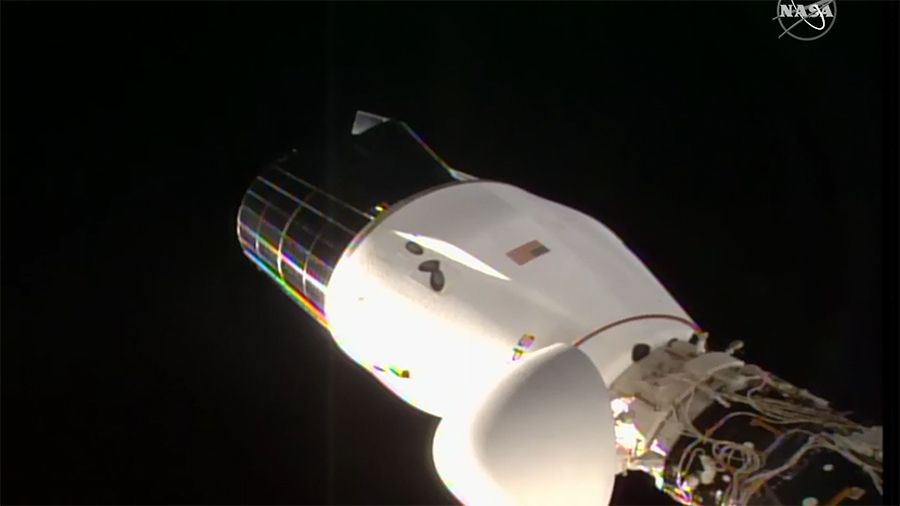Bad weather on Earth delays SpaceX Dragon’s return from space station

Poor weather on Earth forced a SpaceX supply ship to wave off the opportunity to make the first successful autonomous undocking from the International Space Station on Monday (Jan. 11).
The upgraded Dragon cargo ship, hauling 5,200 lbs. (2,500 kilograms) of scientific experiments and other supplies, was supposed to depart the orbiting complex at 10 a.m. EST (1500 GMT).
NASA and SpaceX decided to abandon the attempt at 9:53 a.m. EST (1453 GMT) due to poor weather at the craft’s splashdown site in the Atlantic Ocean off the coast of Daytona, Fla. The two entities will decide later when to make the next undocking attempt, officials said on NASA TV, which broadcast the undocking attempt live.
SpaceX’s upgraded Cargo Dragon capsule can carry 20% more cargo (and experiments) compared to its predecessor and can splash down in the Atlantic Ocean rather than the Pacific, making for a faster turnaround time on science since experiments can arrive at the nearby NASA Kennedy Space Center in as little as four hours. The new Dragon can also remain on station twice as long as previous cargo Dragon types, allowing for longer science investigations.
Video: See SpaceX’s 1st automated uncrewed docking at space station
Related: SpaceX launches upgraded Cargo Dragon to space station for NASA
This Cargo Dragon launched on Dec. 6 and made SpaceX’s first autonomous supply ship docking at the International Space Station about 24 hours later. This mission, called CRS-21, marked the first time a Cargo Dragon did not use the Canadarm2 robotic arm to berth to the space station.
This mission also marks the first time two Dragon spacecraft were docked at the space station simultaneously, NASA said on NASA TV, since a Crew Dragon is currently parked at the orbiting complex after ferrying four astronauts to the station in November.
In a statement, NASA officials said the CRS-21 Dragon will bring “significantly more science back to Earth than possible in previous Dragon capsules” due to upgrades in the cargo spacecraft. Dragon’s return near NASA’s Kennedy Space Center in Florida will also be the first time such an event has happened since the agency’s space shuttle fleet retired in 2011, allowing the science to be processed there.
A selection of the returning experiments includes:
- Cardinal Heart, which examines how gravity changes cardiovascular (heart) cells at the tissue and cell level, which could assist in creating new screenings of heart problems and treatments to address them.
- Space Organogenesis (Japan Aerospace Exploration Agency), which looks at how 3D organ buds grow from human stem cells and monitors the changes in gene expression. The hope is this investigation will push forward the creation of artificial organs.
- Bacterial Adhesion and Corrosion, which examines the bacterial genes used for biofilms and whether the biofilms could corrode stainless steel. It also examines the effectiveness of a disinfectant that could control and remove resistant biofilms on future spaceflight structures.
- Sextant Navigation, which is testing techniques to use a sextant device for emergency navigation on spacecraft that are far from Earth, as NASA hopes to send astronauts to lunar orbit as soon as 2023.
- Fiber Optic Production, which returns experimental optical fibers made in space. These fibers had a blend of zirconium, barium, lanthanum, sodium and aluminum (also called ZBLAN in reference to the chemical formula) and will examine how effective these space-created fibers are compared to their counterparts on Earth.
- Rodent Research-23, which will return live mice from space to examine how arteries, veins, lymphatic structures in the eye and the retina change before and after spaceflight. This work is part of a series of experiments examining why 40% of astronauts have vision impairment during long-duration spaceflights.
NASA added that the ground teams will need to work quickly to bring the precious science back to Earth as the effects of gravity take hold on the experiments.
“After a SpaceX boat scoops the capsule out of the water, a waiting team pulls time-critical science out of the spacecraft and loads it onto a waiting helicopter,” NASA said in the same statement. “The helicopter will deliver this science to shore a few hours after splashdown. Any remaining scientific cargo will come back either in a second helicopter load or stay aboard the boat and be removed at the port.”
Follow Elizabeth Howell on Twitter @howellspace. Follow us on Twitter @Spacedotcom and on Facebook.
